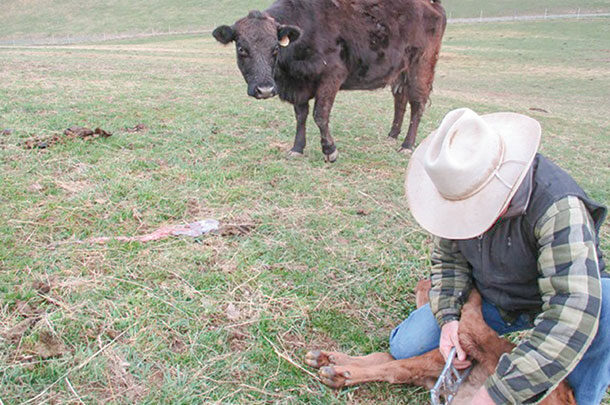Producers purchasing calves through methods such as a state-graded feeder sale will expect the calf to be castrated, dehorned, vaccinated and weaned,” says Dr. Dan Eversole, professor and director of beef cattle programs at Virginia Tech University. Steers will typically bring a higher price than bulls when sold, and meat from a steer will indicate a higher amount of marbling than that from a bull.
One of the methods of castrating a bull is the banding method. It is possible to band any size bull; however, it may be best to castrate earlier in life. “Catch and band the calf when he’s less than 2 days old. At this age, this procedure is not traumatic – the calf will have about 10 minutes of discomfort. This is the time we ought to be doing it,” says Dr. William “Dee” Whittier, DVM, a professor emeritus and veterinarian at Virginia-Maryland College of Veterinary Medicine.
The different banding methods all implement the same concept of “restricting blood flow to the testicles. Since young calves have less blood flow, there is less risk of the band not working properly,” Eversole stated. It is important to note, that in a time when animal welfare is a major concern, banding is seen as one of the more humane methods of castration in that the animal has a quick recovery, and there is no blood involved.
Whittier states there are three classifications of banders.
- “An elastrator uses a ‘donut’ band, and my recommendation is to use only up to 6 weeks of age.”
- “Two intermediate banders that stretch continuous bands over the scrotum. One recommends use for calves up to 400 pounds and the other for calves 450 to 650 pounds.”
- “Banders designed for bigger cattle that use tubing and is stretched around the scrotum and then secured with a clip.”
Regarding bands for the bander, Whittier says to “only use the bands recommended for the specific tool. Bands will deteriorate over time and will deteriorate faster in sunlight. Bands should be safe to use for up to six months. If one breaks when you try to put it on, assume the whole batch of bands has gone bad.”
Elastrator
The elastrator uses “green bands that look like a little green donut,” says Whittier. Elastrators typically can be found as having either three or four prongs over which you will place the band. Elastrators are to be used on smaller calves.
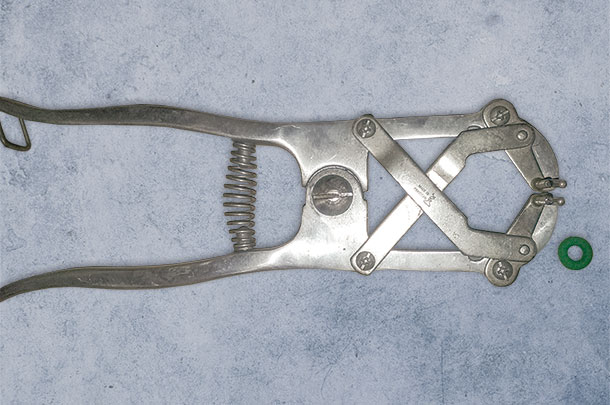
“The elastrator works best when the testicle is about the size of your thumb. The bigger the calf, the more pain the calf will have. There are lots of advantages of banding at 1 to 2 days old,” states Eversole.
He continues, “When you have an open wound from surgical castration, you encounter more problems when there are muddy conditions or flies present. The calf that has been banded will incur less pain, and you have less risk of developing tetanus.”
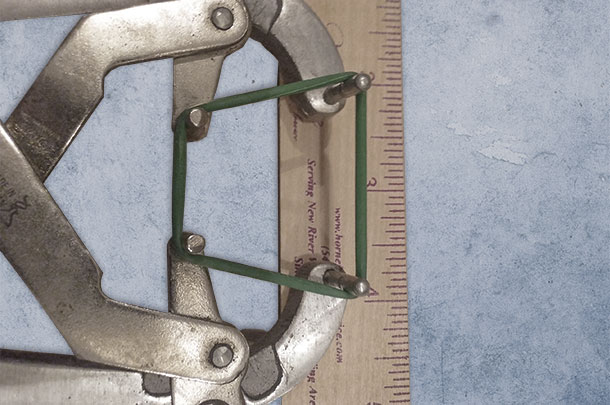
Although the risk of developing tetanus is less when banding smaller calves, it is still recommended the calf be vaccinated for tetanus. Another precaution to avoid tetanus is to “make sure you have a clean, dry place to band – avoid all muddy conditions,” says Eversole.
When banding a newborn calf, in an ideal situation, you would be able to separate the cow from the calf. Since this is not possible in most situations, Eversole recommends to have two people do the procedure – “have one person distract the cow while the other bands the calf.”
For increased safety, producers can utilize the Safety Zone Calf Catcher, which is a cage that attaches to an ATV. Once you approach the calf, the cage lowers. You then enter the cage with the calf and are thus separated from the cow.
Another tool to aid in catching the calf is the Calf Catch, which is a long pole with a hook on the end. You grab the calf’s rear leg with the hook which disables them from running away.
Once you have the calf caught, you can begin the procedure. Whittier explains the “rule of two”: “You have to count to two, three times during the procedure. The first time you count to two is before the procedure. If you can’t count two testicles, don’t put the band on.
Squeeze the handle of the elastrator and pull the testicles down to put them through the opened band. Before you release the handle, make sure you can count two testicles below the band. Take the elastrator off and make sure there are still two testicles below the band. If you can only feel one, carefully cut the band off with a knife and try again. If you realize weeks later that the procedure failed, a surgical procedure will be needed.
“Keep an eye on calves after banding. Problems at this age are rare. Once in awhile, there may be a hernia. Infections in small calves are almost unheard of. Be sure of no swelling and that the calf is acting normal,” says Whittier. He adds, “the calf will lay around for 10 to 15 minutes. This should be over in half an hour. Give the calf attention if it continues to remain uncomfortable.”
Intermediate banders
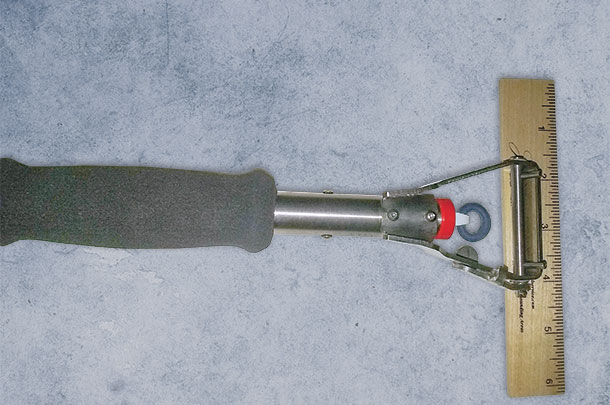
These banders are similar to the elastrator but differ in that they have the ability to castrate calves up to approximately 650 pounds. “These banders stretch continuous bands over the scrotum. Use only bands recommended for the specific tool,” Whittier says.
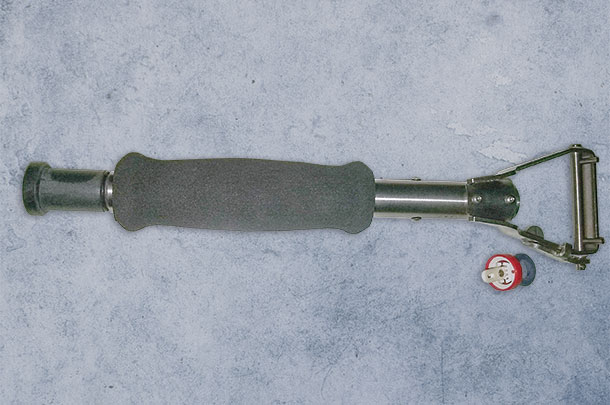
Since these are used with larger calves, you will need to put the calf in a squeeze chute to complete the procedure. The rule of two used for the elastrator applies to this instrument as well.
High-tension banders
One of the most widely known and used high-tension banders is the Callicrate Bander. “These banders are often used by seedstock producers who castrate their bulls at weaning time. We use them on bulls weighing 700 to 800 pounds at Virginia Tech, but you should be able to castrate any size bull with this instrument,” says Eversole.
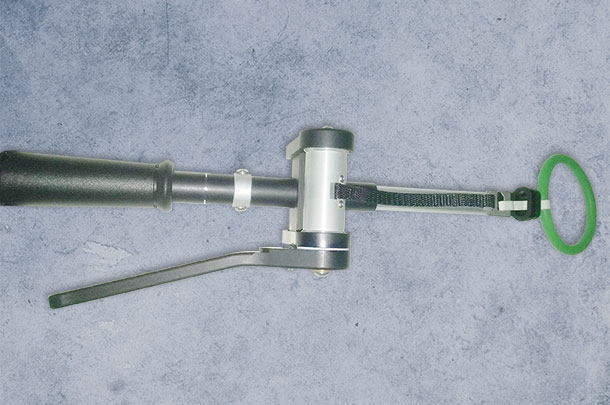
The high-tension bander uses rubber tubing secured with a clip. As with other banders, “make sure both testicles are placed through the band and remain below it prior to completion.”
Eversole recommends having a second person pull the bull’s tail over its topline to limit pain. The high-tension bander uses a ratcheting mechanism to tighten the band. The device has a tension indicator that alerts you when the proper tension is reached. You will then cut the band, which in turn secures a clip to hold the rubber tubing together. “The calf will lay down for two to three hours after the procedure.
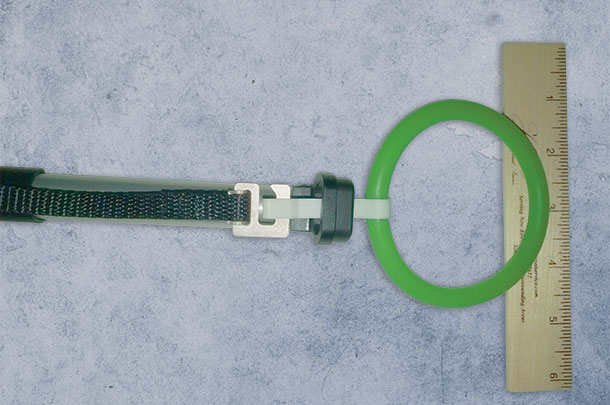
Bigger calves won’t go off feed when the banding method is utilized,” states Eversole. He continues, “The key is making sure you have enough pressure to cut off all blood flow. If nothing has happened to the scrotum after three weeks, you haven’t done it right, but this is not very common.” “It is imperative you provide for tetanus protection, especially when you are banding larger calves,” Whittier says. ![]()
PHOTO 1: Banding is seen as one of the more humane methods of castration because the animal quickly recovers and no blood is involved.
PHOTO 2 & 3: An elastrator uses a “donut” band most suitable for calves up to 6 weeks of age, when testicles are the size of your thumb.
PHOTO 4 & 5: Wee bander with band.
PHOTO 6 & 7: Callicrate Pro Bander with rubber loop. Photos by Virginia Reasor Jones.
Virginia Reasor Jones is a freelance writer based in Virginia.
